Many people have a very hard time fishing in muddy waters. They don’t change up their fishing strategies to account for the low visibility conditions. Bass can’t see your lures as easily and if you don’t fish the right lures, you are going to struggle to catch bass.
Bass Behavior in Muddy Water
It is true that bass have a harder time seeing prey and lures in muddy waters. This is not necessarily a bad thing when it comes to fishing. Because bass have a harder time finding food, they also can have a tougher time determining what is a meal vs what is a lure. In muddy waters, they tend to be less picky about what they eat. As long as they can get close enough to a target, they will most likely bite it. As long as you can get your lure noticed by bass and close to them, you can have lots of success. So how do you increase the odsd?
How To Fish Muddy Waters
The key to fishing muddy waters is using lures that are very noticeable for bass. There are three characteristics that bass are able to hone in on.
- Sound
- Sight
- Vibration
You need to select lures that incorporate these characteristics to make it easy for the bass to find and determine your lure is food.
Best Muddy Water Lures
Here are some categories of lures that should be tried in murky water.
1. Spinnerbaits
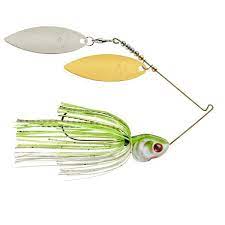 Spinnerbaits are an incredible muddy water lure. Spinnerbaits put off tons of vibration and flash in the water. The blades can be seen and felt by bass very easily and make it very easy to hone in on. You can add trailer baits to a spinnerbait to either give it some more bulk as well. There are three different types of spinner blades that come on these lures. Willowleaf, Colorado, and Indiana spinnerbaits (your can read about each type here). Most commonly, the blades on these spinnerbaits come in gold or silver. The gold color is the easiest to see in dark water and the Colorado blade puts off the most vibration. You can also fish the Colorado blades very slowly compared to the other blades, which gives bass more time to find and eat the lure.
Spinnerbaits are an incredible muddy water lure. Spinnerbaits put off tons of vibration and flash in the water. The blades can be seen and felt by bass very easily and make it very easy to hone in on. You can add trailer baits to a spinnerbait to either give it some more bulk as well. There are three different types of spinner blades that come on these lures. Willowleaf, Colorado, and Indiana spinnerbaits (your can read about each type here). Most commonly, the blades on these spinnerbaits come in gold or silver. The gold color is the easiest to see in dark water and the Colorado blade puts off the most vibration. You can also fish the Colorado blades very slowly compared to the other blades, which gives bass more time to find and eat the lure.
In other words, we recommend having all types in your box, but give a gold colored Colorado style spinnerbait a try in muddy waters!
2. Square Bill Crankbait
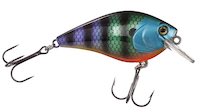 The square bill crankbait has a very wide and erratic motion that creates tons of vibration and can be fished a bit slower than other crankbaits. As a hard-body lure, square bill crankbaits usually contain beads or rattles inside that make lots of sound to go along with the vibration. These lures seem to work especially well in the spring and fall seasons.
The square bill crankbait has a very wide and erratic motion that creates tons of vibration and can be fished a bit slower than other crankbaits. As a hard-body lure, square bill crankbaits usually contain beads or rattles inside that make lots of sound to go along with the vibration. These lures seem to work especially well in the spring and fall seasons.
3. Chatterbait
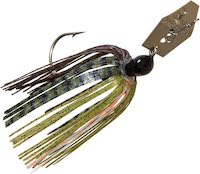 A chatterbait is kind of like a mix between the spinnerbait and crankbait. It has the vibration of a crankbait with the flash and profile of a spinnerbait. Chatterbaits really shine along grass lines in larger lakes. These big lakes will become muddy during heavy rains in the summertime.
A chatterbait is kind of like a mix between the spinnerbait and crankbait. It has the vibration of a crankbait with the flash and profile of a spinnerbait. Chatterbaits really shine along grass lines in larger lakes. These big lakes will become muddy during heavy rains in the summertime.
They certainly in more than just lakes as I typically throw a spinnerbait whenever I am fishing ponds.
4. Flipping Jigs
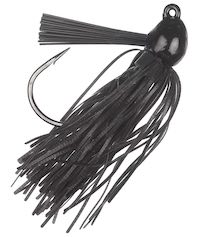 Flipping jigs are a bit of an exception for this list. They don’t have lots of sound, vibration, or flash. But, they can be fished in the heaviest of cover. Muddy water bass will hold very close to structures like trees, docks, pylons, and other cover. Jigs are the best choice for fishing and reeling fish out of heavy cover.
Flipping jigs are a bit of an exception for this list. They don’t have lots of sound, vibration, or flash. But, they can be fished in the heaviest of cover. Muddy water bass will hold very close to structures like trees, docks, pylons, and other cover. Jigs are the best choice for fishing and reeling fish out of heavy cover.
These jigs won’t work great in open water, but slay bass that are hiding in hard to reach places.
5. Buzzbait or Plopper
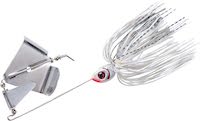 Any good best of list will include at least one top water lure. When fishing muddy water, a buzzbait or plopper style lure is your best bet. These lures have very similar sound and vibration on the surface. I favor a buzzbait in most situations, but ploppers work great too. The splashing blade of a buzzbait is loud, obnoxious, and drives bass crazy. It is also super easy to find as it contrasts the surface and leaves behind a trail of bubbles and ripples.
Any good best of list will include at least one top water lure. When fishing muddy water, a buzzbait or plopper style lure is your best bet. These lures have very similar sound and vibration on the surface. I favor a buzzbait in most situations, but ploppers work great too. The splashing blade of a buzzbait is loud, obnoxious, and drives bass crazy. It is also super easy to find as it contrasts the surface and leaves behind a trail of bubbles and ripples.
If you want to make a lure as easy as possible to find, these lures make tons of sound, vibrations, and nearby will hear, see, or feel the action.
Best Lure Color for Muddy Water
The color of your bait plays a crucial role in lure visibility. The best muddy water colors are either very bright or heavily contrast the water color itself. The most reliable bright colors are:
- White: Works best when fall bass fishing when bass are focusing on shad.
- Chartreuse: Only use chartreuse when the water is extremely muddy.
- Bright Red: Ideal for early spring when bass are eating lots of crawfish.
- Pink: For whatever reason, pink is a great color for summertime pond bass lures.
Contrast Colors:
- Black: Black is really the only color that contrasts muddy water. It is the darkest color there is and absorbs all light that hits it.
When it comes down to it, color likely matters less in muddy water. What is more important is a solid wobble or lure action to attract the fish.
Muddy Water Fishing Gear
The gear used in muddy water is mostly determined by the lures rather than the water. Muddy water lures will tend to be heavier with more vibration. To handle this, your gear will need to be a bit heavier duty. Stick to medium heavy rods that will have no problem casting and retrieving these lures. When it comes to the line you use, muddy water actually gives you more freedom. The muddy water makes it harder for bass to see the line, so you can use heavier line and even use braided fishing line all the time.
Muddy Water Retrieve Techniques
Fishing in muddy or turbid water presents unique challenges, primarily due to reduced visibility. To maximize your chances of success in these conditions, mastering the right retrieve techniques is crucial. Here are some proven retrieve techniques tailored for muddy water fishing:
Slow and Steady Retrieve:
- Start with a slow and consistent retrieve. This technique works well for lures like square bill crankbaits and soft plastics.
- The steady movement allows fish to detect the lure’s vibrations and scent, compensating for their limited sight in muddy water.
- Pay attention to any changes in resistance, as fish often strike during pauses or when they feel the lure.
Stop-and-Start Action:
- Mimic the behavior of injured or distressed prey by intermittently stopping and restarting your retrieve.
- Pauses can pique the curiosity of nearby fish and trigger strikes, as they investigate the unusual stop-and-start movement.
Twitching and Jerking:
- Use lures with a jerkbait or twitchbait design to create erratic movements.
- Twitch the rod tip to make the lure dart and dance, imitating wounded baitfish.
- This technique is especially effective for enticing predator fish in murky water conditions.
Bottom Bouncing:
- For fish species that often hug the bottom in muddy water, such as catfish, consider a bottom-bouncing retrieve.
- Let your bait or lure bump along the bottom, kicking up sediment and creating vibrations to attract fish.
Target Different Depths:
- Muddy water often has fish positioned at varying depths. Experiment with different lure presentations to cover these zones effectively.
- Adjust the depth of your lure by varying retrieval speed, using sinking lures, or employing a suspending lure that remains at a specific depth when paused.
Where To Buy Bass Lures
Bass lures are available at just about every outdoors store, fishing store, and online retailer for outdoor goods. We always recommend supporting local stores when possible. Not only are you supporting a local business owner, but you also can often get great lure advice on the local waters from those with tons of experience.
Of course, you can also shop for bass lures on: Amazon, Bass Pro Shops, Walmart, and tons of other websites. (These links are affilaite links, so if you did purchase on one of these online retailers, we would get a kickback.
Reeling This In
Muddy water provides anglers with unique challenges along with unique advantages. Use lures that make lots of noise and vibration and that can also be seen very easily underwater. Slower retrieves will give bass time to find and eat your bait, so don’t reel in too fast. As with any type of fishing, make sure you experiment for yourself and learn from every cast. Good luck!
Max DesMarais is the founder of hikingandfishing.com. He has a passion for the outdoors and making outdoor education and adventure more accessible. Max is a published author for various outdoor adventure, travel, and marketing websites. He is an experienced hiker, backpacker, fly fisherman, backcountry skier, trail runner, and spends his free time in the outdoors. These adventures allow him to test gear, learn new skills, and experience new places so that he can educate others. Max grew up hiking all around New Hampshire and New England. He became obsessed with the New Hampshire mountains, and the NH 48, where he guided hikes and trail runs in the White Mountains. Since moving out west, Max has continued climbed all of the Colorado 14ers, is always testing gear, learning skills, gaining experience, and building his endurance for outdoor sports. You can read more about his experience here: hikingandfishing/about
